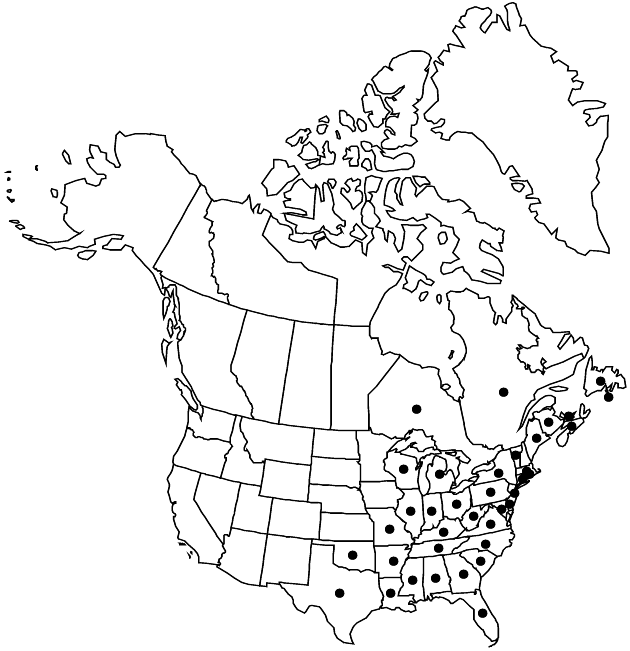Solidago rugosa
Gard. Dict. ed. 8, Solidago no. 25. 1768.
Plants 30–200 cm; rhizomes long-creeping, forming clones. Stems 1–50+, erect, glabrous or densely hispid to strigose. Leaves: basal withering by flowering; proximal cauline usually withering by flowering, sessile, blades elliptic to lanceolate, 68–104 × 20–25 mm, margins sharply serrate, apices acute to attenuate, abaxial faces usually hispido-strigose (at least on main nerves), nerves sometimes prominent, abaxial glabrate; mid to distal cauline sessile, blades lanceolate, elliptic or ovate, (15–)40–75(–90) × (6–)12–22(–32) mm, largest at midstem, somewhat reduced to much reduced distally, margins coarsely to finely serrate, ciliate, indument similar to proximal or denser. Heads 50–1500, secund, in secund-pyramidal paniculiform arrays 7–36(–50) × 9–26 cm, compact to lax, branches divergent and recurved, longest 0.8–34 cm, leafy-bracteate. Peduncles 1–1.8 mm, sparsely to densely hispido-strigillose; bracteoles linear- lanceolate to ovate. Involucres narrowly campanulate, (2–)2.5–3.5(–4.5) mm. Phyllaries in 3–4 series, strongly unequal, lanceolate to linear-lanceolate, acute to obtuse. Ray florets (4–)6–8(–12); laminae (0.9–)1–1.6(–2.3) × 0.4–0.7 mm. Disc florets (2–)4–6(–8); corollas 2–3.5(–4.5) mm, lobes (0.5–)0.7–1(–1.3) mm. Cypselae (narrowly obconic) 0.9–1.5 mm, moderately strigillose; pappi 1.8–2.5 mm.
Distribution

e North America.
Discussion
Subspecies 2 (2 in the flora).
Solidago rugosa is highly variable in size, array shape, and hairiness. It is similar to members of the S. canadensis complex; it differs in not having 3-nerved leaves. The species is divided into two subspecies and five varieties that can be difficult to distinguish.
Selected References
None.
Lower Taxa
Key
| 1 | Leaves relatively thin, not very rugose, usually sharply toothed, apices acuminate, glabrous or relatively soft-hairy; ray florets (4–)6–11(–13); northern (subsp. rugosa) | > 2 |
| 1 | Leaves relatively thick and firm, strongly rugose-nerved, usually blunt-toothed to subentire, apices often acute, relatively short and stiff hairy; ray florets 4–9; mostly se United States (subsp. aspera) | > 3 |
| 2 | Stems and leaves hairy; e Canada and ne United States s to Virginia | Solidago rugosa var. rugosa |
| 2 | Stems and leaves glabrous; coastal cedar bogs and swamps | Solidago rugosa var. sphagnophila |
| 3 | Arrays narrow, proximal branches not much exceeding subtending leaves; herbage sparsely hairy; mid to higher elevations in mountains | Solidago rugosa var. cronquistiana |
| 3 | Arrays wide, usually with elongate proximal branches greatly exceeding subtending leaves; herbage moderately to densely hairy; lower elevations in mountains, piedmont, and coastal plain | > 4 |
| 4 | Distal cauline leaves lanceolate to elliptic, not much reduced distally; much of range of subspecies | Solidago rugosa var. aspera |
| 4 | Distal cauline leaves ovate, much reduced distally; outer coastal plain | Solidago rugosa var. celtidifolia |